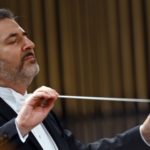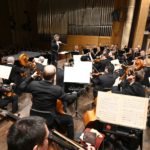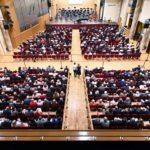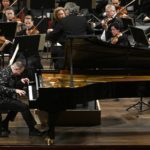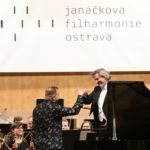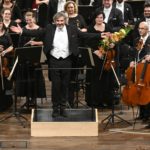Start of the season in Ostrava: audience in face masks and Vondráček excelled again
(review is taken from the portal Klasikaplus.cz, September 12, 2020, author Karla Hofmannová)
The new music season still has the aftertaste of coronavirus as it is necessary to wear face masks even in the concert hall. The number of spectators allowed inside is regulated and they also have separate sectors and cannot move around the foyer as they used to do. However, the organizers of the opening concert of the Janáček philharmonic Ostrava still managed to arrange everything so that the audience felt comfortable and everyone followed the rules, deciding to not acknowledge these “little things”. Simply put, the opening concert will happen, and the season will begin!
The musicians on the stage were, of course, not wearing face masks, as well as the conductor Daniel Raiskin. This artist, originally from St. Petersburg, has become the chief conductor of the Slovak Philharmonic this season, he is also the music director of the Winnipeg Symphony Orchestra, and he will also make a guest appearance in the Belgrade Philharmonic and other cities around the world. The 50-year-old conductor is in full force and artistic invention, with which he proceeded to interpret the compositions of the gala evening.
Leoš Janáček’s Moravian Dances JW VI/7 were the first to be performed. They belong to the period when Janáček intensively collected and edited dances, which were later published by the Czech Music Fund as a set of five parts. The thunderous Kožuch, the whimsical Kalamajka, the ringing Trojky, the solid Silnice, and the deliberate Rožek – dances that were richly instrumented and conducted in a very romantic way, which evoked a relaxed atmosphere.
The Concerto for Piano and Orchestra in G minor Op.33 B 63 by Antonín Dvořák, the only piano concerto written by him, is imbued with lightness and radiant brilliance. The piano part is full of runs and sparkling strings, on which the notes are strung like glittering beads. Performed by the pianist Lukáš Vondráček, these sparling strings gleamed and glittered. The pianist seemed to pierce the keys with his electrifying fingers that also sent the electricity to the audience. The incredible tempo light as a breeze was the opposite of the orchestra that played a romantic chord, like soft velvet beneath glistening pearl cords.
The collaboration of the individual solo instruments was not left behind. The solo entrances by French horns, which were both soft and colorful and striking, but mainly pure in deployment and precise intonation, the luminous flute complemented the glitter of the piano, the wooden instruments carried the melody, and the bows stroked and filled the color of the instrumentation. The finale culminated in a piano equilibrist and with a joyful conclusion. The admirable performance of the soloist Lukáš Vondráček was fully supported by the compact performance of the orchestra. The enthusiastic audience begged for an encore, which was delivered in the form of a composition by Clause Debussy called The Sunken Cathedral. Here, the soloist unleashed the chord part and dazzled the audience, especially in contrast to the mysterious impressionist piano at the beginning and end of the composition.
After a break, where the most sought-after commodity was fresh air, Antonín Dvořák’s Scherzo Capriccioso, op.66, B. 131 was performed. The romantic author used his favorite instruments here. The redounding fanfares of the French horn began, followed by the dance plenum of the orchestra, which performed with the joy of music-making. The last performance of the night was Symphony No. 9 in E-flat major, op. 70 by Dimitri Shostakovich. Since the Beethoven period, the ninth symphony is supposed to be serious and to bring philosophical and inventive ideas. However, Shostakovich did not fulfill this expectation and, on the contrary, wrote his ninth symphony as ironic merriment and ridicule of pathos and for the relaxation of the psyche in society. Frolic and simplicity of the themes, playfulness and nostalgia and lamentation, ferocity, and resentment. Ostinato rhythms in the orchestra are sometimes threatening thanks to trombones in the striking entrance.
For a Czech contemporary listener, the symphony no longer has the same message as in the post-war period when the composer wrote his work. Nevertheless, the masterful balance remains on the border of merriment and satire, heroism, and despair, all presented in a masterful performance by the philharmonic. The color and striking power of the individual instruments are highlighted by the wooden baffle, which allows using of a wide dynamic range and large dramatic gradation. All of this is under the firm and focused direction of the conductor Daniel Raiskin, who is very close to Russian music. This evening was surely one of the best that the Janáček Philharmonic Ostrava could offer to its audience.

